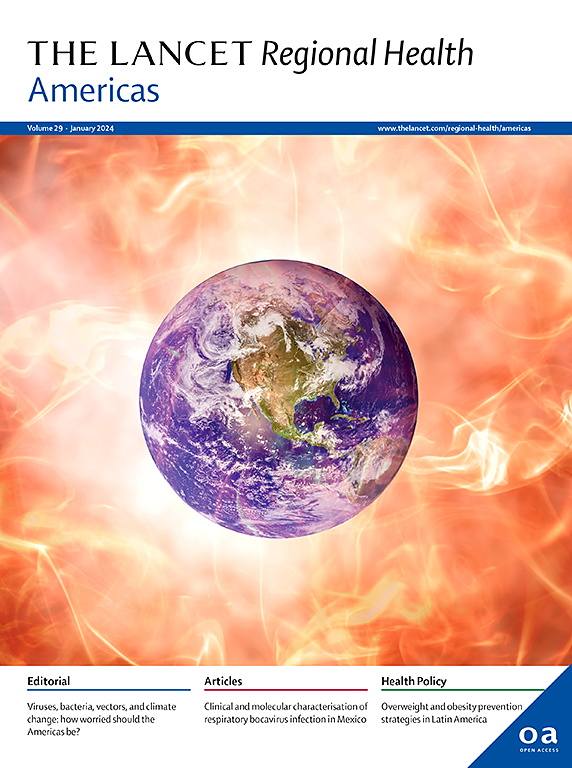天气和极端事件对巴西亚马逊地区疟疾传播的影响:一项病例交叉和基于人群的研究
IF 7
Q1 HEALTH CARE SCIENCES & SERVICES
引用次数: 0
摘要
自1950年以来,亚马逊地区出现了越来越多的非典型气候模式,其中一些是由El Niño-Southern涛动(El Niño或La Niña)事件引起的。在2023-2024年,该地区面临着有史以来最严重的干旱。这些天气模式是疟疾的主要驱动因素。森林砍伐加剧了这些影响。这项研究估计了2003年至2022年天气和ENSO事件对巴西亚马逊地区疟疾传播的影响。方法采用巴西疟疾流行病学监测信息系统(Sivep-Malaria)每天报告的疟疾病例的个人数据。采用病例交叉方法分析了滞后天气变量和ENSO事件对亚马逊流域和州一级疟疾传播的影响。采用广义加性准泊松模型评估ENSO事件对疟疾病例的影响。从2003年到2022年,巴西亚马逊地区记录了5381105例疟疾病例。感染前一周的温度在25.64至30.85°C之间,降雨量为4.46厘米,分别使疟疾感染风险增加9% (95% CI: 8-10%)和86% (95% CI: 35-155%)。两周和三周的滞后温度(25.64°C)和日变化(6.75°C)最大可使疟疾感染风险降低27% (95% CI: 19-33%)和59% (95% CI: 52-69%)。各州在关系上的差异是显著的。ENSO事件显著影响天气条件和疟疾传播,El Niño和La Niña分别与疟疾病例净减少2179例(95% CI: 1837, 2520)和37,258例(95% CI: 37,171, 37,345)相关,具有明显的时空异质性。本研究阐明了天气和ENSO事件对巴西亚马逊地区疟疾传播的短期和长期影响。这些结果强调了该地区天气对疟疾传播影响的高度异质性,以及基于天气预报和发展早期预警系统的主动和精细疟疾控制的必要性,以实现消除疟疾。本研究得到了美国国家过敏和传染病研究所校内研究部(奖励号:2U19AI089681-08)和国立卫生研究院基金会(奖励号:NIH/T32 AI007535)的支持。本文章由计算机程序翻译,如有差异,请以英文原文为准。
The impact of weather and extreme events on malaria transmission in the Brazilian Amazon: a case-crossover and population-based study
Background
Since 1950, there have been increasingly atypical climatological patterns in the Amazon, some caused by El Niño-Southern Oscillation (ENSO) events (El Niño or La Niña). In 2023–2024, the region faced the most severe droughts in recorded history. These weather patterns are major drivers of malaria. Deforestation has exacerbated these impacts. This study estimates the impact of weather and ENSO events on malaria transmission in the Brazilian Amazon from 2003 to 2022.
Methods
We used daily individual-level data on reported malaria cases from the Brazilian Malaria Epidemiological Surveillance Information System (Sivep-Malaria). A case-crossover approach was used to analyze the effects of lagged weather variables and ENSO events on malaria transmission at the Amazon-wide and state levels. Generalized additive quasi-Poisson models were used to assess the influence of ENSO events on malaria cases.
Findings
From 2003 to 2022, 5,381,105 malaria cases were recorded in the Brazilian Amazon. Temperatures between 25.64 and 30.85 °C and precipitation >4.46 cm in the week prior to infection increased malaria infection risk up to 9% (95% CI: 8–10%) and 86% (95% CI: 35–155%), respectively. Two- and three-week lagged temperatures >25.64 °C and diurnal variation >6.75 °C reduced malaria infection risk by a maximum of 27% (95% CI: 19–33%) and 59% (95% CI: 52–69%). State-specific variations in relationships were notable. ENSO events significantly influenced weather conditions and malaria transmission, with El Niño and La Niña associated with a net reduction in malaria cases of 2179 (95% CI: 1837, 2520) and 37,258 (95% CI: 37,171, 37,345), respectively, with marked spatiotemporal heterogeneity in effect.
Interpretation
This study clarifies the short- and long-term influences of weather and ENSO events on malaria transmission in the Brazilian Amazon. The results underscore the high degree of heterogeneity in the effects of weather on malaria transmission in the region, and the need for proactive and fine-scale malaria control based on weather forecasting and the development of early warning systems to achieve malaria elimination.
Funding
This research was supported by the Division of Intramural Research at the National Institute of Allergy and Infectious Diseases (Award Number: 2U19AI089681-08) and the Foundation for the National Institutes of Health (Award Number: NIH/T32 AI007535).
求助全文
通过发布文献求助,成功后即可免费获取论文全文。
去求助
来源期刊

Lancet Regional Health-Americas
Multiple-
CiteScore
8.00
自引率
0.00%
发文量
0
期刊介绍:
The Lancet Regional Health – Americas, an open-access journal, contributes to The Lancet's global initiative by focusing on health-care quality and access in the Americas. It aims to advance clinical practice and health policy in the region, promoting better health outcomes. The journal publishes high-quality original research advocating change or shedding light on clinical practice and health policy. It welcomes submissions on various regional health topics, including infectious diseases, non-communicable diseases, child and adolescent health, maternal and reproductive health, emergency care, health policy, and health equity.
 求助内容:
求助内容: 应助结果提醒方式:
应助结果提醒方式:


